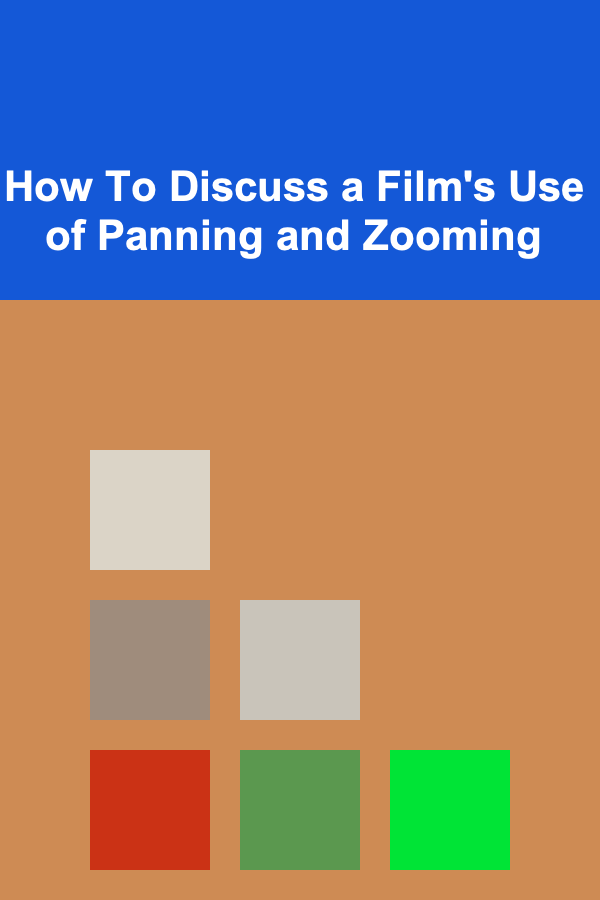
How To Discuss a Film's Use of Panning and Zooming
ebook include PDF & Audio bundle (Micro Guide)
$12.99$10.99
Limited Time Offer! Order within the next:

Cinematography is one of the most essential elements of filmmaking. It dictates how a story is visually communicated to the audience. Among the various techniques employed by cinematographers, panning and zooming are two of the most widely used methods for creating dynamic visual experiences. These techniques are not merely technical; they are integral to the narrative structure and emotional tone of a film. Understanding how to discuss their use involves analyzing the purpose, effect, and significance of these movements within the context of the film's storytelling.
In this article, we will explore the technical aspects of panning and zooming, their emotional and narrative functions, and how they contribute to the overall cinematic experience. By learning how to examine these techniques critically, you can develop a deeper appreciation for the craft of cinematography and understand how they help in shaping a film's mood and meaning.
The Basics of Panning and Zooming
Before diving into the analysis, it's important to understand what panning and zooming are and how they differ.
Panning
Panning refers to the horizontal movement of the camera. The term comes from the word "panorama," which is derived from the Greek word "pan," meaning "all," and "horama," meaning "view" or "sight." In a panning shot, the camera moves horizontally from one side to another, typically on a fixed axis. Panning is used to follow a subject, reveal a wider scene, or simply provide a sense of movement within the frame.
Panning can be done at various speeds, from slow, smooth sweeps to fast, jarring motions. The pace of the pan can influence the emotional impact of the scene. A slow pan might evoke a sense of calm or contemplation, while a fast pan might generate excitement or unease.
Zooming
Zooming, on the other hand, is a change in the focal length of the lens to make the subject appear closer or farther away. Unlike panning, zooming does not involve moving the camera physically. Instead, the lens itself adjusts, magnifying or reducing the scene within the frame.
There are two types of zooming: zooming in and zooming out. A zoom-in brings the viewer closer to a subject, creating an intensified focus on that subject. A zoom-out reveals more of the surrounding environment, often providing context or creating a sense of distance. Zooming can create a feeling of intimacy or alienation, depending on the direction and speed of the zoom.
The Function of Panning and Zooming in Film
Both panning and zooming are used not just for technical or aesthetic purposes but also for narrative and emotional manipulation. These techniques serve various functions, from establishing a setting to influencing the viewer's emotional engagement with the characters.
1. Establishing Space and Setting
One of the primary uses of panning is to establish the physical space within a film. A wide pan can give the audience a sense of the environment or location. For example, a slow pan across a vast landscape in a Western film might suggest the isolation and desolation of the setting. Similarly, a quick pan through a crowded city street can create a sense of chaos and movement.
In addition to physical space, panning can also establish social or psychological space. For instance, a pan that follows a character across a room can visually suggest their journey or transition. It can also provide insight into the character's state of mind---whether they are feeling overwhelmed by their environment or if they are in control.
2. Creating Emotional Tone and Atmosphere
The way a pan or zoom is executed has a significant impact on the emotional tone of a scene. A slow pan across a somber scene, like a cemetery or an abandoned house, can heighten the sense of melancholy or loss. Conversely, a rapid pan can generate tension, urgency, or excitement. This is particularly effective in action films or thrillers, where panning quickly from one character to another can suggest a fast-paced, high-stakes situation.
Similarly, zooming in on a character's face can create intimacy, focusing the audience's attention on their emotions or thoughts. This is often used in dramas or psychological thrillers, where the audience is invited to feel what the character is experiencing. Zooming out, on the other hand, can be used to establish distance, disorientation, or a sense of insignificance.
3. Directing the Viewer's Attention
Panning and zooming are both effective tools for directing the viewer's attention to specific elements in the frame. Panning allows the filmmaker to lead the audience's gaze across the frame, revealing important details gradually. This can be used to introduce new characters or to reveal information about a scene in a controlled, deliberate manner. For example, a pan from a character's face to an object on a table could subtly reveal important information without the need for dialogue.
Zooming serves a similar function by isolating a subject in the frame and drawing the viewer's attention directly to it. For instance, zooming in on a character's eyes during a moment of realization can heighten the emotional significance of the moment. On the other hand, zooming out can reveal the larger context, guiding the audience's understanding of the narrative.
4. Heightening or Breaking Tension
In action sequences or moments of high emotional intensity, panning and zooming can be used to heighten or break tension. A fast pan can amplify the chaos of a chase scene, creating a sense of urgency and speed. A zoom-in during a climactic moment can emphasize the gravity of a situation, such as a character preparing to make a crucial decision.
Conversely, a slow pan or a gradual zoom-out can create a sense of release, signaling a shift in mood. After a tense confrontation, a slow zoom-out might suggest a sense of resolution or acceptance, offering the audience a chance to process the events.
5. Symbolism and Metaphor
Sometimes, panning and zooming are used symbolically to reinforce the themes of the film. A zoom-out that reveals a character as small or insignificant within a vast landscape could symbolize their sense of alienation or isolation. A slow pan across an object or location might suggest its importance to the character's journey or the overall narrative.
In some cases, panning and zooming are used to convey psychological or emotional states. For example, a pan that circles around a character could evoke a sense of confusion or disorientation, while a zoom-in on a character's face can intensify their feelings of fear or desire.
How to Analyze Panning and Zooming in a Film
When analyzing a film's use of panning and zooming, it's essential to consider both the technical execution and the broader narrative and emotional implications. Here are some key points to keep in mind when discussing these techniques:
1. Technical Considerations
- Speed and Fluidity: How fast or slow is the pan or zoom? Is it smooth or jerky? The speed and fluidity can greatly affect the tone of a scene. A slow pan can create a sense of calm or contemplation, while a fast pan might generate excitement or chaos.
- Camera Movement vs. Static Shots: Is the pan or zoom the only movement in the scene, or is it contrasted with stillness? A dramatic zoom-in during a moment of stillness can have a more significant emotional impact.
- Point of View: Consider whether the panning or zooming is from a particular character's point of view. For example, a zoom-in on a character's face could suggest their internal emotional state, while a wide pan might convey their perspective on the world around them.
2. Contextual Significance
- Narrative Function: How does the panning or zooming contribute to the storytelling? Does it reveal important information, such as a character's motivations, the environment, or the plot? Does it indicate a change in the character's emotional state or relationship with the environment?
- Emotional Impact: How does the movement affect the audience emotionally? Does it create tension, intimacy, or distance? Does it heighten the stakes of a scene or provide a sense of release?
- Symbolic Meaning: Are there symbolic meanings attached to the use of panning or zooming? Does it represent a character's journey, emotional growth, or decline? Does the movement reflect larger themes in the film, such as alienation, control, or freedom?
3. Cultural and Historical Context
- Genre Considerations: Different genres use panning and zooming in distinct ways. For example, horror films often employ slow pans to build suspense, while action films might use rapid pans to convey speed and excitement. Understanding the conventions of the genre can help you interpret the purpose of these movements.
- Historical Context: Panning and zooming techniques have evolved over time. The use of these techniques in classic films may differ from modern films due to technological advances, changes in cinematic style, or shifts in audience expectations. Consider how the film you're analyzing fits into the broader history of cinema.
Conclusion
Panning and zooming are fundamental techniques in filmmaking that go beyond mere technical functions. They shape the emotional and narrative structure of a film, guiding the audience's attention, influencing mood, and providing deeper insight into characters and themes. By understanding how to analyze these movements, you can gain a more profound appreciation for the role of cinematography in storytelling. Whether you are a film scholar, a budding filmmaker, or simply an enthusiast, recognizing the nuances of panning and zooming enhances your ability to engage with and interpret films on a deeper level.

A Beginner's Guide to Using Cashback Apps for Extra Savings
Read More
How to Assess the Condition of an Apartment During a Tour
Read More
How to Create a Functional Linen Closet
Read More
How to Create a Functional, Space-Saving Dining Area
Read More
How to Develop a System for Organizing Your Digital Contacts
Read More
How to Use Real Estate as a Part of Your Financial Plan
Read MoreOther Products

A Beginner's Guide to Using Cashback Apps for Extra Savings
Read More
How to Assess the Condition of an Apartment During a Tour
Read More
How to Create a Functional Linen Closet
Read More
How to Create a Functional, Space-Saving Dining Area
Read More
How to Develop a System for Organizing Your Digital Contacts
Read More